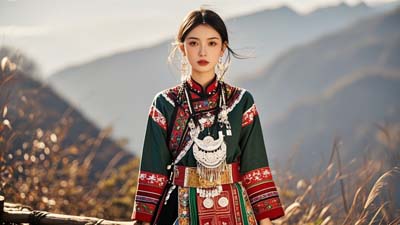
China is one of the most culturally diverse nations on the planet. China has over 56 nationalities and ethnicities. Among those 56 ethnic groups, there are 55 ethnic minorities and one main ethnicity, Han. Although all of the ethnicities live within the same boundaries lines of China, each has its own unique characteristics. Each has different religious beliefs, clothing, and lifestyles.
There are several different ways of identifying the different ethnicities in China, but the easiest is by looking at the clothing each wears. We have a word in Chinese that defines this way of dressing and it is called:
传统民族服饰 (Chuántǒng mínzú fúshì): traditional national costumes.
传统 (Chuántǒng): tradition.
民族 (Mínzú): nation; nationality; people; race.
服饰 (Fúshì): dress and personal adornment.
National costumes refer to the unique costumes of each ethnic group’s own culture. They can also be called local costumes, or folk costumes. In urban areas or populations of some ethnic countries, people spend most of their daily life in suits, but they will be dressed in traditional costumes in festivals and other formal occasions.
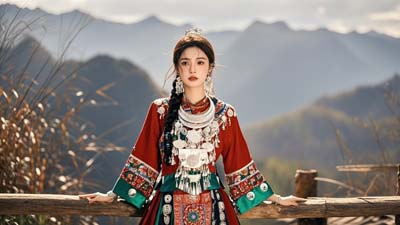
The Han nationality is the most populous and widely distributed nationality in China. Over years and years, the Han have developed costumes that reflect their own unique style. Due to the influence of geographical environment, natural climate, production and lifestyle, history, culture, customs and other factors, the traditional Han costumes have a rich and varied appearance. But in general, they have many similarities, such as the same style structure, similar craftsmanship, the same color choice, and especially the similarity of pattern decoration. Due to the influence of Confucian ritual concepts and hierarchies, there have been strict regulations on the clothes of the emperor’s bureaucrats and the people of the Yi people. There are clear requirements for people to wear on various occasions and ceremonies, including color. Shapes, patterns and even fabrics should not be used casually.
A complete Hanfu garment is assembled from several pieces of clothing into a basic attire:
衣 (Yī): unisex open cross-collar garment.
袍 (Páo): closed full-body garment worn by men only.
褥 (Rù): open cross-collar shirt.
衫 (Shān): open cross-collar shirt worn over the yi.
裙 (Qún): skirt.
裤 (Kù): pants.
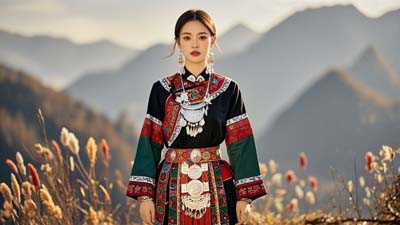
There are four main forms:
旗袍 (Qípáo): cheongsam.
Cheongsam can be worn by men and women regardless of season. The cheongsam is a female dress with distinctive Chinese features and enjoys a growing popularity in the international world of high fashion. Easy to slip on and comfortable to wear, the cheongsam fits the female Chinese figure very well. Its neck is high, collar closed, and its sleeves may be either short, medium or full length, depending on the season and preference. The dress is buttoned on the right side, with a loose chest, a fitting waist, and slits up from the sides, all of which combine to set off the beauty of the female shape.
马褂 (Mǎguà): mandarin jacket.
Mandarin jacket is dressed as a wealthy man in the spring and autumn and winter.
坎肩 (Kǎnjiān): waistcoat.
Waistcoat is a female’s coat.
套裤 (Tàokù): leggings.
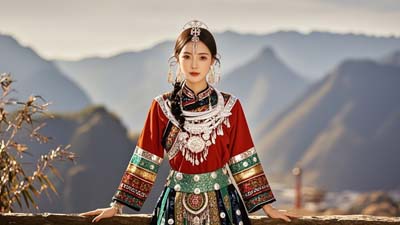
The Miao nationality is an international nation originating in China with a large population. There are many styles of Miao costumes. According to a few vague statistics, there are more than 200 styles, and the age span is large.
Its main features are silver, Miao embroidery and batik. It is the most gorgeous of all the national costumes in China, and it also has held within it the intangible cultural heritage of our country.
Miao costumes are mainly composed of three types.
童装 (Tóngzhuāng): children’s garments.
便装 (Biànzhuāng): casual wear.
盛装 (Shèngzhuāng): splendid attire.
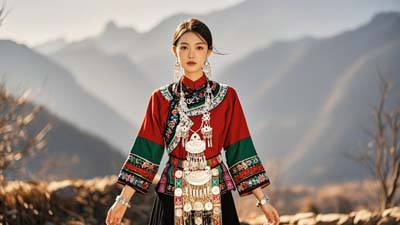
Its main sign is on the head.
Men love to wear a “圆帽 (Yuán mào) white round cap.”
Women often wear a “面纱 (Miànshā) veil.”
Their clothing not only serves as a decoration, but also protects the body. Moreover, the Hui people’s clothing is very particular. For example, the elderly Hui women wear black or brown headscarves in winter, white shawls in summer, and also during the summer have the habit of pulling up their trousers and tying them below the knee to help with the heat. Young women wear red, green or blue headscarves in winter and red, green and yellow tulles in summer.
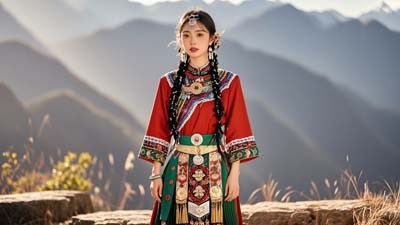
The Mongolians wear “长袍 (Chángpáo) robe” in all seasons.
The Mongolian people have long lived in the grasslands of the Saibei region, and both men and women love to wear robes. Mongolian costumes are also known as Mongolian robes, which mainly includes robes, belts, boots, and jewelry. However, there are differences in style depending on the region. Mongolian costumes have rich grassland features, easy to ride on pommel horses. Wearing a robe in spring and autumn, wearing a single robe and cotton gown in summer. Men’s robes are generally relatively large, and women’s robes are more tight, showing the slim and fit of the woman’s body.
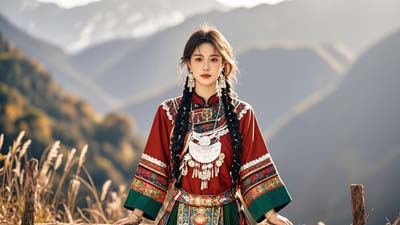
A. 满族 (Mǎnzú)
B. 大和族 (Dàhé zú)
C. 蒙古族 (Ménggǔ zú)
D. 汉族 (Hànzú)
Becky Zhang is a teacher at eChineseLearning.com. She has over eight years of experience teaching Mandarin Chinese to foreign students and promoting Chinese culture. She lives in Beijing but loves traveling to ancient Chinese villages. One day she’d like to be a tour guide in China!
The Eastern Carnival-火把节 The Torch Festival
Celebrating Spring Festival in China
Chinese Culture
General Chinese (Beginner Level)
General Chinese (Intermediate Level)



